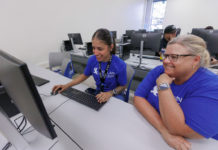
Green team executive chef Ashley Bonesio leaned in close to examine a pan of duck breasts and legs prepared by her team members. Her fellow chefs buzzed around her, one taking fresh baked tortilla chips out of an oven while another scooped an enticing spinach dip into a bowl for plating. Across the kitchen, red team executive chef Lucino Ortega brushed a pineapple glaze over pork, while his team members arranged coconut milk rice on a plate.
While it looks and smells like the the kitchen of a four-star restaurant, it isn’t. It’s the Culinary II class at Gilroy High School, where students are learning skills they can carry with them long after they leave the classrom. On Oct. 16, the 20 upper level culinary students spent around four hours competing in the “Aluminum Chef” competition, creating a three course meal from ingredients that teacher Betty Ewing revealed to them when they entered class that morning. The teams had the choice of tackling duck, salmon, tri-tip or pork.
“When we first came in here, Chef Betty just sort of pulled off the tarp with all the meat and she’s like ‘go for it’,” Bonesio said noting her team opted to cook duck as it was more challenging. “For our vegetables, I had a group go off and say ‘OK, pick something with color; something that will actually go good together.’ Me being in charge, I kind of trusted them to go off and pick something and they did a really good job.”
The green team prepared duck leg in a carrot, onion and celery mixture along with duck breast cooked with bell peppers and celery for their protein dish. Both teams also needed to prepare a starch, appetizer and vegetable as well as dessert. The green team opted for mashed potatoes, sautéed white carrots with bell peppers and celery, spinach dip with chips for their appetizer and apple pie.
The red team decided to keep things more tropical, preparing pork with a pineapple sauce for their protein and coconut milk rice as their starch. Keeping with their Hawaiian theme, the team prepared a stir-fry and asparagus and finished off the meal with apple pie.
The students were excused from their other classes that morning, allowing them to take part in the competition. Ortega was in his element and said he wished this class could be an everyday occurrence.
“I like it because it’s fun; it’s not like other classes,” the senior chef said. “You get to stand up and move around. She (Ewing) teaches us to be professional like in the restaurant business. Not only do you learn how to cook, you learn management skills.”
The teams—made up of a mix of classes—worked seamlessly together, but the morning was not without its struggles. The students had to overcome an early morning fire drill, food delivery interruption and a plumbing mishap, which closed off the back half of the kitchen.
“It’s just like a real restaurant,” Ewing said with a laugh.
Ewing started the culinary program at Gilroy High in 2009 after teaching a similar program at a Los Altos school for 12 years prior. She is a self-taught chef who opened her first restaurant in 1978 at 26 years old.
Ewing’s passion for cooking and teaching young people stems from her own struggles at that age. As a teenager, she was homeless and worked at a daycare center and other odd jobs until she found financial stability and was able to open her restaurant. Teaching the students at Gilroy High—and at-risk teens between 17 and 19 years of age through her nonprofit, the El Cajon Project—allows them to develop a set of skills to fall back on, even if they don’t choose a career in the industry, Ewing said.
“Even if they chose to be a journalist, they’ve got to support themselves while they’re doing it,” she said. “That could be being a barista, fast food—I hate to say it—and fine food; it’s always a back-up. Like when you have kids, maybe I’ll just go work on Saturdays and Sundays working in a kitchen and I can pay for my daycare. There’s just so many avenues for kids to work.”
The GHS students are learning about more than just cooking—they are learning how to run a business. Every day they cook up various dishes, like pork chops, tri-tip or soup to sell to students and faculty. This helps keep the program running as it raises money for groceries and other necessities. Last year alone, the culinary program raised around $18,000 from food sales.
Ewing is also teaching her students proper workplace behavior by reining in things like bad language, improper behavior or hygiene—things that can be detrimental to teens and often are the cause for dismissal from their first jobs, she said.
“They’re all working together, socializing, not arguing. Now the real question is who’s going to clean up?,” Ewing said with a smile. “All these guys, I would hire them—and that’s something to be said.”
Students like Ortega and Bonesio will have a leg-up on their senior counterparts as this class has helped them see the culinary industry as a viable career choice.
“It’s a good thing to experience because I actually want to be a chef when I eventually go to college and everything,” Bonesio said. “It’s good to start getting that experience now.”














